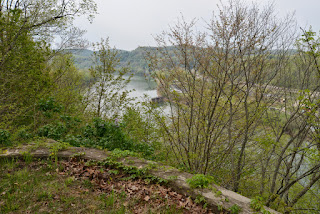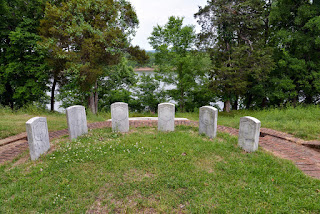With the intent to get caught up on my blogs from our travels this past winter/spring, I will combine three of our visits into one blog here. First subject will be Albert Gallatin's home, Friendship Hill National Historic Site in Springhill Township, PA. From Wiki: The home itself is made up of seven sections. The earliest of these is the original brick house built in 1789. This original structure was constructed in the Federalist style with a Flemish bond. Along the north side of the brick house, a simple frame dwelling was added in 1798. The Stone House was the next structure added on by Gallatin in 1823, this is a three and a half story structure, the largest of the house. This was the only Gallatin structure not built and overseen by Albert himself. This portion was built and overseen by one of his sons, Albert Rolaz Gallatin. A stone kitchen was added in 1824, this ends the Gallatin era of the house. The rest of the structures of the house include a State Dining Room in 1895, a south bedroom wing was finished in 1902, and the servants' quarters were added in 1903. Those were the portions built by the later owners of the house.
From Wiki: Albert Gallatin was a Swiss-American politician, diplomat, ethnologist and linguist. He served as a Congressman, Senator, United States Ambassador and was the longest-serving United States Secretary of the Treasury. In 1831, he founded the University of the City of New York, now New York University.
It was a nice walk around the grounds and inside the old home. The ranger was most helpful in describing the events of Mr Gallatin's life and loves. His first wife is supposedly buried down the hill from the house on the bank of the river.
On to Shiloh now...I am a Civil War enthusiast. Having lived in Virginia for all my adult life, nearly 50 years, I have learned so much about the events of that terrible American war. And add to that, Shiloh and Vicksburg. So many men/boys, so much blood, so many maimed and scarred bodies and spirits. Makes so melancholy for all the parents who never saw their boys and husbands and fathers ever again. And many of those parents to this day have no idea where these brave men are buried, or even what State they rest in peace. Sad! So sad! And walking through this "resting place" makes one so keenly aware when so many markers are "unknown but to God only". Not only here, but Vicksburg too.
Below are three tablets that describe the events of the three major armies that fought at Shiloh. For only three days. Three days, that's right, and so many souls lost. The fighting was just ferocious.
Just look at those reported as killed, injured and lost.
Above, down this grade and just around the curve is the landing where all of Grant's army came ashore.
Next, Vicksburg. On the banks of the Mississippi, Lincoln knew that Vicksburg was THE KEY to winning the war. By cutting off the South's ability to re-supply their armies from foreign support as well as the bread basket of the deep south, Grant could literally out shoot and out feed his opponent.
I cannot tell how many memorials are erected here, and in Shiloh as well. In fact, States are still erecting memorials in the parks. Below is an Illinois tribute which is probably the largest and most costly.
The Illinois State Memorial is located on Union Avenue at milepost 1.8, tour stop #2. Dedicated on
October 26, 1906. Stone Mountain (GA) granite forms the base and stairway. Above the base is Georgia white marble. There are forty-seven steps in the long stairway, one for each day of the Siege of Vicksburg. Modeled after the Roman Pantheon, the monument has sixty unique bronze tablets lining its interior walls, naming all 36,325 Illinois soldiers who participated in the Vicksburg Campaign. The monument stands sixty-two feet in height, and originally cost $194,423.92, paid by the state of Illinois. There 47 steps up to the floor level of the memorial, denoting the 47 days of the siege. 

I think the tablet above describes the role of the tunnel pics below.
I found this display very interesting. After 100 years this relic of the war was uplifted from it's watery grave just below the Vicksburg Bluffs and restored as best as could be. Here are the efforts of that restoration. Wow! Here in the Battlefield! Who thinks that ships are part of the battles. Oh, that's right: Duh, Monitor and Merrimack...in Hampton Roads.
And here are some of the many artifacts that have been preserved from the sinking of the Cairo.
Above, Nancy in front of the high-water marks on the levy wall of past floods of the River.
From Wiki: The park includes 1,325 historic monuments and markers, 20 miles of historic trenches and earthworks, a 16-mile tour road, a 12.5-mile walking trail, two antebellum homes, 144 emplaced cannons, restored gunboat USS Cairo (sunk on December 12, 1862, on the Yazoo River, recovered successfully in 1964), and the Grant's Canal site, where the Union army attempted to build a canal to let their ships bypass Confederate artillery fire. The Cairo, also known as the "Hardluck Ironclad," was the first U.S. ship in history to be sunk by a torpedo/mine. It was raised in 1964.
Above and below, the two Commanders of the opposing forces during the siege: Lt, Gen John C. Pemberton and Maj Gen Ulysses S Grant.
That's about it for this very long blog, written at Merced River RV Park, CA on May 30, 2015. So, until the next blog, RVing Beach Bums signing off.



























































